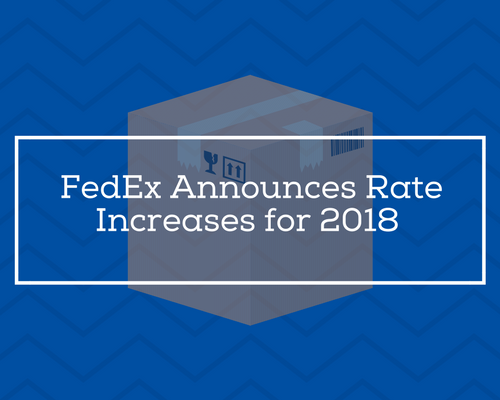
You may have heard that FedEx announced its General Rate Increases (GRI) for 2018. In the past few years, UPS has been the first of the two major small package carriers to make an announcement for the coming year, but this time FedEx is taking the lead.
Here are the announced average increases that will take effect January 1, 2018:
- 4.9% for FedEx Express domestic and international services
- 3.5% for FedEx One Rate
- 4.9% for FedEx Ground and FedEx Home Delivery
- 4.9% for FedEx Freight
As it’s important to remember every year, these averages don’t paint a complete picture. The zones you typically ship to and the services you typically use could dramatically affect the actual increase you’ll see on your invoices. Some are much higher than the average, while others are much lower or remain the same. UPS is likely to make its announcement for 2018 rates soon and if history is any indication, the averages will be similar to its competitor.
FedEx and UPS traditionally have similar average rate increases, but in the last few years their base rates have diverged a bit. Ground base rates used to be nearly identical, but in 2017 the two carriers took different increases in different zones, making it harder to compare apples-to-apples. On top of that, they also implemented slightly different approaches to dimensional (DIM) weight pricing, by using different DIM factors. As a result, looking at what would be most cost effective for you and how your rates will change has become more complicated.
Another trend that we’ve seen from UPS and FedEx is the announcements of additional changes throughout the year, separate from the GRIs. The announced averages have gone down in recent years, but these mid-year adjustments can sometimes have a larger impact.
One example of this is the new peak season surcharges that UPS is implementing for the holidays this year. UPS recently announced that it will apply a 27-cent charge on all ground residential packages during its busiest weeks in November and December. FedEx is taking a notably different approach and forgoing any additional holiday residential surcharges except for packages that are big or bulky enough to require special handling.
Both UPS and FedEx attribute charges like this to the rise of e-commerce, which has brought a sharp increase in residential shipments, particularly oversized items like furniture and exercise equipment. These kind of parcel shipments put a strain on their networks and their sorting machinery, and they've been finding ways to make up for these costs.
FedEx is also making a couple of additional moves to address the changing nature of parcel shipments in 2018. It will now apply a surcharge for shipments with third-party billing – mimicking a move that UPS made at the beginning of 2016. FedEx will also begin applying a DIM factor of 139 to all SmartPost parcels, effective January 22. UPS already applies DIM weight pricing to SurePost packages, but uses a higher DIM factor for packages 1,728 cubic inches and under.
Every year, when the new rates for UPS and FedEx are out, PartnerShip does a complete analysis so you can determine what effect it will have on your business. Subscribe to the PartnerShip Connection blog to be alerted when it’s out so you can start planning for the new year and learn how to mitigate the rising costs of small package shipping.
